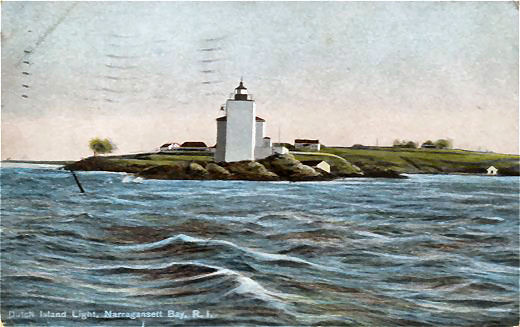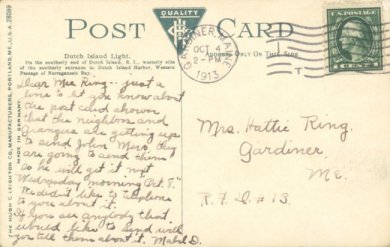![]()
Postal History Introduction
Stampless
Covers
1846
to 1900 Issues
1901-1950
Issues
1951-2003
Issues
Cancels
&
Miscellaneous
Postal
Stationery
Post
Cards
Air
Mail
First
Day &
Event Covers
Parcel Post/Special Delivery
Registered & Official Mail
Commercial & Advertising
Revenue & Postage Due
Wildlife & Game Issues
Complete List of RI Issues
|
Rhode Island Picture
Post Cards |
||
|
||
|
The postcard above was sent as an invitation to join something called a Postcard Shower. I don't know what that is, but it sounds like these folks sent of a huge bunch of postcards to John Mero on the 8th of October. The address is for a Rural Free Delivery route and the card was sent and received locally in Gardiner, Maine with a CDS (Circular Date Stamp) and machine cancel. The messages reads as follows: Dear Mrs. Ring -- Just a line to let you know about the postcard shower that the neighbors and grangers are getting up to send John Mero. They are going to send them so he will get it next Wednesday morning "Oct. 8." We didn't like to telephone to you about it. If you see anybody that would like to send will you tell them about it. Mabel D. DUTCH ISLAND LIGHTHOUSE During my early teenage years, growing up in Saunderstown, we would sometimes take a boat over to Dutch Island to go exploring and enjoy a picnic outing. There was an old coastal fort and gun batteries located on the island dating from the Civil War period. They were supposed to be off limits, however, the locks were broken off on many of the old underground forts and exploring these was a lot fun (and scary) for a 14 year old. (The only way to get to Dutch Island was by private boat.) The fort was named Fort Greeble at the turn of the century and during World War I had an army contingent of around 500 men. The fortifications wee abandoned in 1947. Dutch Island is located in the lower Narragansett Bay just west-southwest of Jamestown (Conanicut) Island and to the east of Saunderstown, Rhode Island. The island comprises 81 acres and was named after the Dutch traders of the West India Company who established a trading post there in the early 1600s. The Dutch Island Light was first established in 1825 to mark the west passage of Narragansett Bay and consisted of a 30 foot tower built of native stone. The first keeper was Captain William Dennis who held the post until 1846 when he was replaced by Robert Weeden. (I attended high school in North Kingstown with several members of the Weeden family, including a Bob Weeden - I don't know if they are related, but chances are good that there is a connection.) The second light tower and a lighthouse were built in 1857 and were constructed of brick. The tower was 42 feet in height and had a Fourth Order Fresnel lens. The light was automated in 1947 and the keeper's house torn down by the Coast Guard in the mid 1950s. The light was officially disestablished in 1979 and replaced by offshore buoys. The island and lighthouse are now owned by the Rhode Island Department of Environmental Management. The Dutch Island Lighthouse Society, a chapter of the American Lighthouse Foundation is raising funds to begin a restoration of the light. The design phase of the restoration was expected to begin sometime during 2004 and construction the following year. |
![]()
RI Historical Society
The Post Offices
Home Page
RI Tercentenary Issue History
RI Philatelic Society
Recently Added Pages
Philatelic Primer
Rhode Island Around the World
Rhode Island
Town Postmarks
Other Websites of Interest

